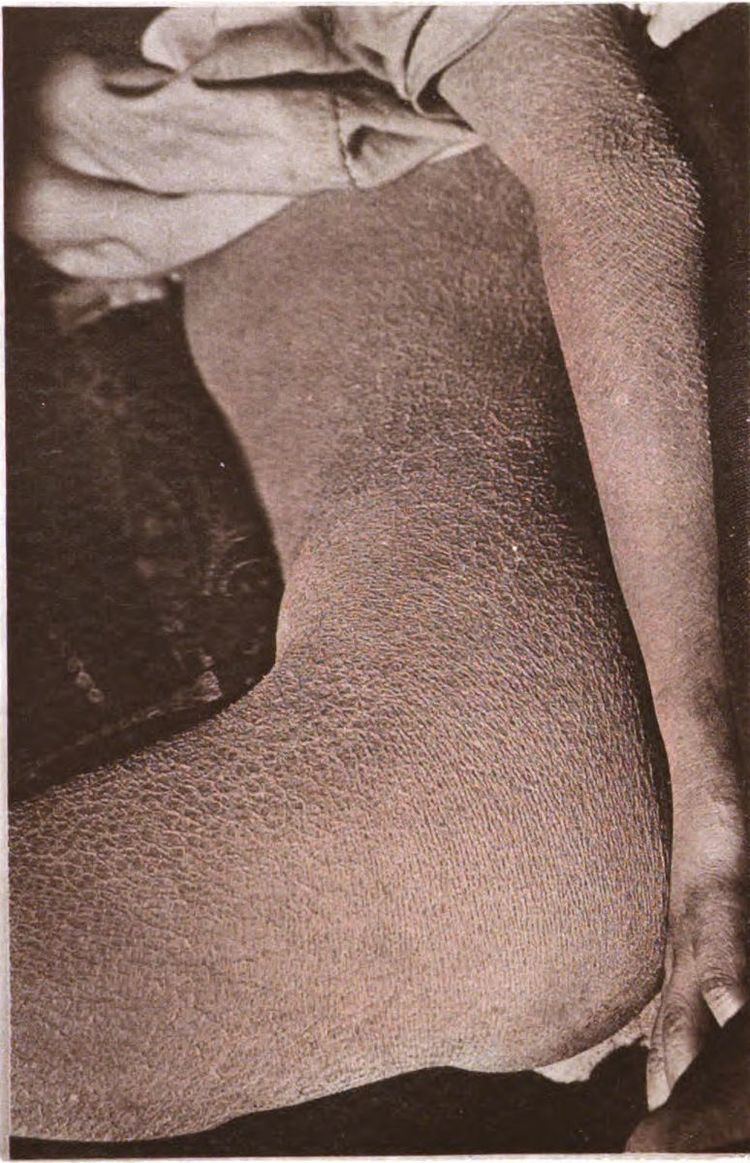Specialty Dermatology ICD-9-CM 757.1 eMedicine article/1198130 | ICD-10 Q80 DiseasesDB 6646 MeSH D007057 | |
 | ||
Ichthyosis (plural ichthyoses) is a heterogeneous family of at least 28, generalized, mostly genetic skin disorders.
Contents
All types of ichthyosis have dry, thickened, scaly or flaky skin. In many types there is cracked skin, which is said to resemble the scales on a fish; the word ichthyosis comes from the Ancient Greek ἰχθύς (ichthys), meaning "fish."
The severity of symptoms can vary enormously, from the mildest, most common, type such as ichthyosis vulgaris which may be mistaken for normal dry skin up to life-threatening conditions such as harlequin type ichthyosis. Ichthyosis vulgaris accounts for more than 95% of cases.
Types
There are many types of ichthyoses and an exact diagnosis may be difficult. Types of ichthyoses are classified by their appearance and their genetic cause. Ichthyosis caused by the same gene can vary considerably in severity and symptoms. Some ichthyoses do not appear to fit exactly into any one type. Different genes can produce ichthyoses with similar symptoms. Of note, X-linked ichthyosis is associated with Kallmann syndrome (close to KAL1 gene). The most common or well-known types are as follows:
Non-genetic ichthyosis
Diagnosis
A physician often can diagnose ichthyosis by looking at the skin. A family history is very useful. In some cases, a skin biopsy is done to help to confirm the diagnosis. In some instances, genetic testing may be helpful in making a diagnosis. Diabetes has not been definitively linked to acquired ichthyosis or ichthyosis vulgaris; however, there are case reports associating new onset ichthyosis with diabetes.
Ichthyosis has been found to be more common in Native American, Asian, Mongolian groups. There is no way to prevent ichthyosis.
Treatments
Treatments for ichthyosis often take the form of topical application of creams and emollient oils, in an attempt to hydrate the skin. Creams containing lactic acid have been shown to work exceptionally well in some cases. Application of propylene glycol is another treatment method. Retinoids are used for some conditions.
Exposure to sunlight may improve or worsen the condition. In some cases, excess dead skin sloughs off much better from wet tanned skin after bathing or a swim, although the dry skin might be preferable to the damaging effects of sun exposure.
There can be ocular manifestations of ichthyosis, such as corneal and ocular surface diseases. Vascularizing keratitis, which is more commonly found in congenital keratitis-ichythosis-deafness (KID), may worsen with isotretinoin therapy.
Other animals
Ichthyosis or ichthyosis-like disorders exist for several types of animals, including cattle, chickens, llamas, mice, and dogs. Ichthyosis of varying severity is well documented in some popular breeds of domestic dogs. The most common breeds to have ichthyosis are Golden retrievers, American bulldogs, Jack Russell terriers, and Cairn terriers.
